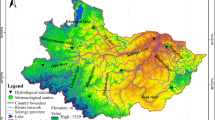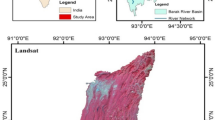Abstract
Glaciers are also known as solid reservoirs, and in this regard, Pakistan is a blessed country to have enriched glaciers. The change in glacial extent becomes very crucial for rivers whose discharges are associated with glacier melt. Even a little change in the glacial extent may bring a significant change in the resulting river flows. Considering climate change scenarios, many researchers have predicted future flows in such catchments. But in almost all such studies, the reduction in the glaciers is not normally based on any rational. Therefore, research is needed in order to estimate how glaciers are actually behaving under the change of temperature and precipitations to better estimate the future flows. For this purpose, Chitral watershed was considered as the study area. The seasonal change in the snow extent was estimated by using MODIS data for various years that helped to identify the month with minimum glacial extent. With the help of remote sensing, unsupervised classification was performed to estimate the glacier area in Chitral watershed. The results show a definite receding trend with respect to time in the glaciers of the region for the past decade.
















Similar content being viewed by others
References
Akhtar, M., Ahmad, N., & Booij, M. J. (2008). The impact of climate change on the water resources of Hindu Kush–Karakorum–Himalaya region under different glacier coverage scenarios. Journal of Hydrology, 355, 148–163.
Bajracharya, S. R., & Shrestha, B. (Eds.) (2011). The status of glaciers in the Hindu Kush-Himalayan region. Kathmandu: International Centre for Integrated Mountain Development (ICIMOD)
Bogacka, B. (2004). Time series. Course handouts. Available from: http://www.maths.qmul.ac.uk/~bb/TS_MainPage.html>.volume = [o].
Böhm, R., Auer, I., Brunetti, M., Maugeri, M., Nanni, T., & Schöner, W. (2001). Regional temperature variability in the European Alps: 1760–1998 from homogenized instrumental time series. International Journal of Climatology, 21(14), 1779–1801.
Campbell, J. G., & Soomro, B. (2005). Inventory of glaciers and glacial lakes and the identification of potential glacial lake outburst floods (GLOFs) affected by global warming in the mountains of Himalayan region.
Frey, H., Paul, F., & Strozzi, T. (2012). Compilation of a glacier inventory for the western Himalayas from satellite data: methods, challenges, and results. Remote Sensing of Environment, 124(2012), 832–843.
Gardner, A., Moholdt, G., Cogley, J., Wouters, B., Arendt, A., Wahr, J., Berthier, E., Hock, R., Pfeffer, W., Kaser, G., Ligtenberg, S., Bolch, T., Sharp, M., Hagen, J., Van den Broeke, M., & Paul, F. (2013). A reconciled estimate of glacier contributions to sea level rise: 2003 to 2009. Science 852–857.
Hock, R., De Woul, M., Radić, V., & Dyurgerov, M. (2009). Mountain glaciers and ice caps around Antarctica make a large sea‐level rise contribution. Geophysical Research Letters, 36(7), L07501.
Houghton, J. T., Ding, Y., Griggs, D. J., Noguer, M., van der Linden, P. J., Dai, X., Maskell, K., & Johnson, C. A. (eds.), (2001). The scientific basis, Contribution of Working Group I to the Third Assessment Report of the Intergovernmental Panel on Climate Change, Cambridge University Press, p. 881.
Immerzeel, W., Droogers, P., de Jong, S. M., & Bierkens, M. F. P. (2009). Large-scale monitoring of snow cover and runoff simulation in Himalayan river basins using remote sensing. Remote Sensing of Environment, 113(1), 40–49.
Intergovernmental panel on Climate Change (IPCC). (2007). IPCC statement on the melting of Himalayan glaciers.
Kaser, G., Cogley, J., Dyurgerov, M., Meier, M., & Ohmura, A. (2006). Mass balance of glaciers and ice caps: consensus estimates for 1961–2004. Geophysical Research Letters, 33(19), L19501.
Kaser, G., Grosshauser, M., & Marzeion, B. (2010). Contribution potential of glaciers to water availability in different climate regimes. Proceedings of the National Academy of Sciences of the United States of America, 107(47), 20223–20227.
Mohammadi, K., Eslami, H. R., & Kahawita, R. (2010). Parameter estimation of an ARMA model for river flow forecasting using goal programming. Journal of Hydrology, 331, 293–299.
Naeem, U. A., Hashmi, H. N., Shamim, M. A., & Ejaz, N. (2012). Flow variation in astore river under assumed glaciated extents dueto climate change. Pakistan Journal of Engineering and Applied Sciences , 11, 73–81.
Naeem, U. A., Hashmi, H. N., Rehman, H., & Shakir, A. S. (2013). Flow trends in river Chitral due to different scenarios of glaciated extent. KSCE Journal of Civil Engineering, 17(1), 244–251.
Naeem, U. A., Rehman, H., Hashmi, H. N., Shakir, A. S., Ghumman, A. R., & Shamim, M. A. (2014). Ranking sensitive calibrating parameters of UBC watershed model. KSCE Journal of Civil Engineering, 19(05), 1538–1547.
Raper, S., & Braithwaite, R. (2006). Low sea level rise projections from mountain glaciers and icecaps under global warming. Nature, 439, 311–313.
Shi, Y., & Liu, S. (2000). Estimation on the response of glaciers in China to the global warmingin the 21st century. Chinese Science Bulletin, 45(7), 668–672.
Sorg, A., Bolch, T., Stoffel, M., Solomina, O., & Beniston, M. (2012). Climate change impacts on glaciers and runoff in Tien Shan (Central Asia). Nature Climate Change, 2, 725–731.
Immerzeel, W. W., van Beek, L. P. H., & Bierkens, M. F. P. (2010). Climate change will affect the asian water towers. Science, 328, 1382.
Immerzeel, W. W., van Beek, L. P. H., Konz, M., Shrestha, A. B. & Bierkens, M. F. P. (2012). Hydrological response to climate change in a glacierized catchment in the Himalayas. Climatic Change, 110, 721–736
WWF Nepal Program. (2005). An overview of glaciers, glacier retreat, and subsequent impacts in Nepal, India and China.
Ye, Q., Kang, S., Chen, F., & Wang, J. (2006). Monitoring glacier variations on Gela Dandong Mountain, central Tibetan Plateau, from 1969 to 2002 using remote-sensing and GIS technologies. Journal of Glaciology, 52, 179.
Zamir, U. (2012). Monitoring receding of glaciers and in north-eastern Pakistan through geo-informatics techniques. Science Technology and Development, 31(4), 327–334.
Zhao, L., Ding, R., & Moore, J. (2014). Glacier volume and area change by 2050 in high mountain Asia. Global and Planetary Change, 122(2014), 197–207.
Author information
Authors and Affiliations
Corresponding author
Rights and permissions
About this article
Cite this article
Naeem, U.A., Shamim, M.A., Ejaz, N. et al. Investigation of temporal change in glacial extent of Chitral watershed using Landsat data. Environ Monit Assess 188, 43 (2016). https://doi.org/10.1007/s10661-015-5026-0
Received:
Accepted:
Published:
DOI: https://doi.org/10.1007/s10661-015-5026-0




